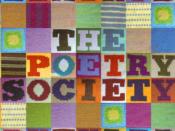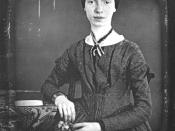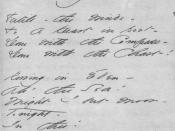Analysis of 'Because I Could Not Stop for Death'
The poets of the nineteenth century wrote on a variety of topics. One often used topic is that of death. The theme of death has been approached in many different ways. Emily Dickinson is one of the numerous poets who uses death as the subject of several of her poems. In her poem 'Because I Could Not Stop for Death,' death is portrayed as a gentleman who comes to give the speaker a ride to eternity. Throughout the poem, Dickinson develops her unusual interpretation of death and, by doing so, composes a poem full of imagery that is both unique and thought provoking. Through Dickinson's precise style of writing, effective use of literary elements, and vivid imagery, she creates a poem that can be interpreted in many different ways.
The precise form that Dickinson uses throughout 'Because' helps convey her message to the reader.
The poem is written in five quatrains. The way in which each stanza is written in a quatrain gives the poem unity and makes it easy to read. 'I Could Not Stop for Death' gives the reader a feeling of forward movement through the second and third quatrain. For example, in line 5, Dickinson begins death's journey with a slow, forward movement, which can be seen as she writes, 'We slowly drove-He knew no haste.' The third quatrain seems to speed up as the trinity of death, immortality, and the speaker pass the children playing, the fields of grain, and the setting sun one after another. The poem seems to get faster and faster as life goes through its course. In lines 17 and 18, however, the poem seems to slow down as Dickinson writes, 'We paused before a House that seemed /...


